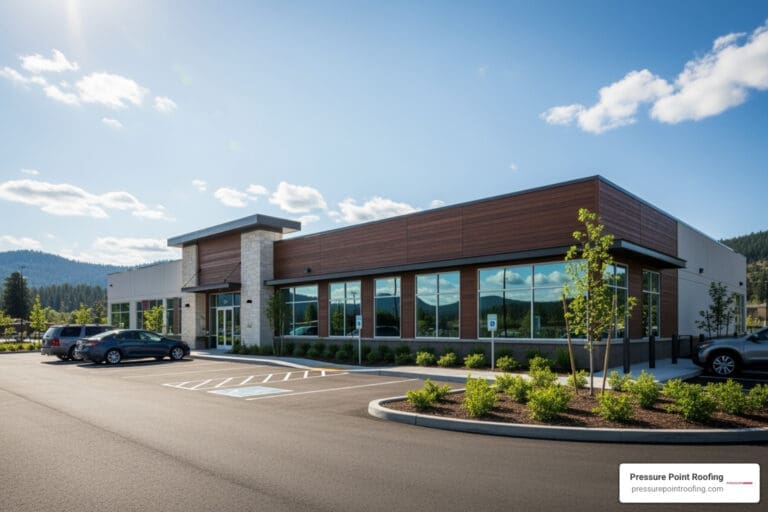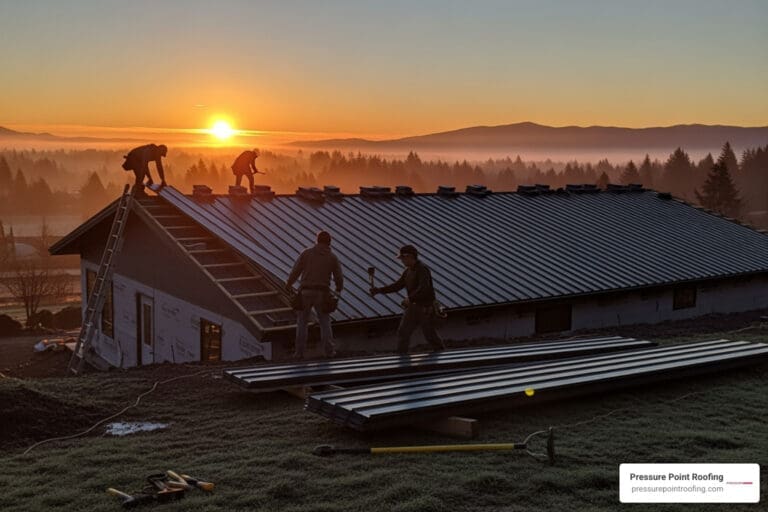How to Spot Roof Damage from Windstorms in Oregon
 Windstorms are common in Oregon, particularly during fall and winter when powerful Pacific storms roll across the state. These storms can bring wind gusts that exceed 60 mph, often resulting in significant damage to homes, especially roofs. For Oregon homeowners, understanding how to identify roof damage from windstorms is essential to protecting their investment, maintaining structural integrity, and preventing costly repairs.
Windstorms are common in Oregon, particularly during fall and winter when powerful Pacific storms roll across the state. These storms can bring wind gusts that exceed 60 mph, often resulting in significant damage to homes, especially roofs. For Oregon homeowners, understanding how to identify roof damage from windstorms is essential to protecting their investment, maintaining structural integrity, and preventing costly repairs.
Why Windstorms Are Dangerous for Your Roof
Oregon’s topography—coastal breezes, valleys, and mountain passes—makes it prone to intense wind events. These winds can cause both immediate and progressive roof damage. High winds don’t simply blow over trees; they also lift roofing materials, loosen flashing, and create vulnerabilities that can lead to leaks and structural issues. Even a brief windstorm can cause serious problems if the roof is older or poorly maintained.
Roofing systems are designed to resist a certain wind load, but the way wind interacts with a structure means damage often occurs in the most vulnerable areas—edges, corners, ridges, and areas around chimneys, vents, or skylights.
Signs of Roof Damage from Windstorms
After a windstorm, you should perform a thorough visual inspection of your home’s exterior and roof (as safely as possible). Here are key indicators of roof damage from windstorms:
1. Missing or Lifted Shingles
High winds can curl, crack, or completely tear off asphalt shingles. Look for areas where shingles are missing entirely, or where the tabs are lifted or bent. Missing shingles expose the roof deck, making your home vulnerable to leaks.
2. Granule Loss
Even if shingles appear intact, strong wind can strip away the protective granules on their surface. Check your gutters and downspouts for granule buildup—this is a sign that your shingles are aging prematurely and losing their waterproofing ability.
3. Damaged Flashing
Flashing (metal sheeting used around vents, chimneys, and valleys) is often pulled loose during windstorms. If you notice flashing that is bent, missing, or peeling away from the roof, it may allow water intrusion.
4. Debris Impact
Flying branches and other debris can puncture or dent the roofing surface. Look for signs of physical impact—especially dents in metal roofs, cracked shingles, or holes near tree branches.
5. Water Spots on Ceilings or Walls
Water intrusion is often the first interior sign of roof damage. If you notice brown stains, sagging paint, or moisture on your ceilings or walls, your roof may have developed a leak due to wind damage.
6. Gutter and Soffit Damage
Gutters and soffits can become detached or bent under wind stress. Loose or broken gutters not only suggest recent wind damage but can also contribute to future water damage if left unrepaired.
7. Unusual Roof Movement
Severe storms can loosen the roof’s structure itself. If you hear creaking or feel vibrations during or after a storm, it could be a sign that structural fasteners or decking materials have been compromised.
Dangers of Ignoring Windstorm Damage
Oregon’s frequent rainfall makes windstorm-related roof damage even more hazardous. A single lifted shingle may not leak immediately, but once water penetrates the barrier, it can cause:
- Mold growth in the attic or insulation
- Wood rot in rafters or sheathing
- Electrical hazards due to moisture
- A weakened roofing system more susceptible to future storms
The longer roof damage from windstorms goes unnoticed, the more extensive and expensive the repairs may become. Early intervention is critical to preventing a small problem from evolving into a major issue.
When to Call a Professional Roofer
While some damage is easy to spot, other forms require a trained eye. If you suspect your roof may have been compromised during a windstorm, schedule a professional roof inspection as soon as possible. At Pressure Point Roofing, our certified inspectors understand the unique challenges of Oregon weather and are trained to identify even subtle signs of roof damage from windstorms.
A professional inspection typically includes:
- A full perimeter walk-around to assess visible damage
- A comprehensive rooftop inspection for structural and material integrity
- Attic inspection for signs of water infiltration
- A written report outlining any needed repairs or insurance documentation
How Pressure Point Roofing Can Help
As a trusted roofing contractor serving Southern Oregon for over 30 years, Pressure Point Roofing provides expert storm damage assessments, repair services, and complete roof replacements when necessary. Here’s how we support homeowners after a windstorm:
1. Rapid Response
We understand the urgency after a storm. Our team responds quickly to inspection and repair requests to prevent further damage.
2. Insurance Claim Support
If your damage qualifies for insurance coverage, we’ll provide documentation and work with your insurance provider to ensure your claim is processed smoothly.
3. Expert Repairs
Our skilled roofing professionals are experienced with all roofing systems common in Oregon, including asphalt shingles, metal roofing, and cedar shake. We ensure all repairs restore full functionality and appearance.
4. Preventive Maintenance
We also offer roof maintenance services to strengthen your roof against future windstorms. This includes replacing worn shingles, resealing flashing, clearing gutters, and reinforcing weak spots.
Proactive Steps to Take Before the Next Storm
Being proactive can reduce the risk of future roof damage from windstorms:
- Trim Trees: Remove overhanging limbs that could fall on your roof.
- Secure Loose Items: Patio furniture and yard décor can become dangerous projectiles in strong winds.
- Schedule Annual Inspections: Have your roof professionally checked every year, especially before winter storms arrive.
- Update Roofing Materials: Consider impact-resistant shingles or improved fastening methods if you live in a wind-prone area.
Pressure Point Roofing: Your First Line of Defense Against Oregon’s Wind and Rain.
Windstorms are an unavoidable part of life in Oregon—but long-term roof damage doesn’t have to be. By knowing what signs to look for and taking swift action, you can protect your home from expensive and dangerous consequences. If you’re unsure about the condition of your roof after a recent storm, contact Pressure Point Roofing today for a thorough inspection and peace of mind.
Contact us now at pressurepointroofing.com or call us for a free consultation about windstorm damage and roofing solutions tailored to Oregon homes.
Schedule a Consultation
By submitting this form, I agree to receive calls and text messages (including those sent using automated technology) from Pressure Point Roofing, LLC and its representatives at the number provided. Message and data rates may apply. Message frequency may vary. Consent is not required as a condition of purchase. Reply STOP to unsubscribe at any time.
Related Content
Partners and Awards












